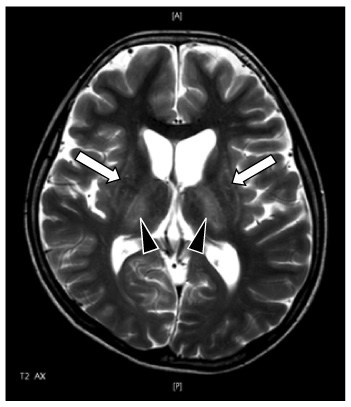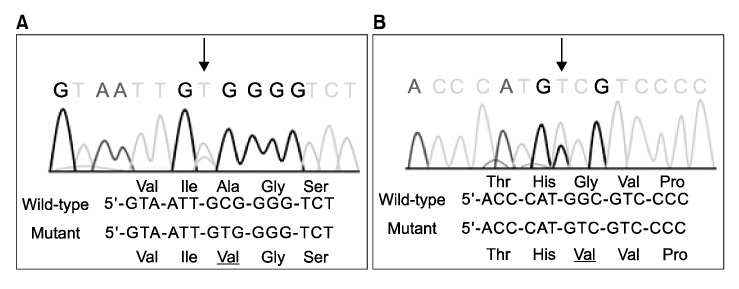Korean J Pediatr Gastroenterol Nutr.
2011 Mar;14(1):86-90. 10.5223/kjpgn.2011.14.1.86.
Hypocalcemic Tetany in a 13-Year-Old Girl with Wilson's Disease
- Affiliations
-
- 1Department of Pediatrics, Yonsei University College of Medicine, Seoul, Korea. KHONG@yuhs.ac
- KMID: 1451211
- DOI: http://doi.org/10.5223/kjpgn.2011.14.1.86
Abstract
- Wilson's disease is an autosomal recessive disorder marked by disruptions in copper metabolism which leads to accumulation of copper in the liver, brain, cornea, and other tissues. Manifestations of this disease are more likely to be hepatic during early childhood and neurologic in adolescent. In addition, abnormalities that develop during disease progression may result in other manifestations such as hematologic, endocrine, or renal findings. Here we report a 13-year-old girl who presented with hypocalcemic tetany shortly after being diagnosed with Wilson's disease. Despite aggressive calcium, magnesium, and vitamin D replacement therapy, the hypocalcemia and hypomagnesemia did not promptly respond. Mineral levels in the blood took longer than 3 weeks to normalize. We speculate that a parathyroid insufficiency and disrupted vitamin D metabolism caused by copper accumulation and hepatic dysfunction resulted in hypocalcemic tetany.
MeSH Terms
Figure
Reference
-
1. Seo JK. Molecular genetic testing and diagnosis of Wilson disease. Korean J Pediatr Gastroenterol Nutr. 2008. 11:72–82.2. Gitlin N. Wilson's disease: the scourge of copper. J Hepatol. 1998. 28:734–739.
Article3. Seo JK. Wilson disease: an update. Korean J Hepatol. 2006. 12:333–363.4. Moon JS, Ko JS, Seo JK. Long-term clinical follow-up of Korean children with Wilson disease; twenty years' experience. J Korean Pediatr Soc. 2001. 44:127–138.5. Yamaguchi A, Matsuura A, Arashima S, Kikuchi Y, Kikuchi K. Mutations of ATP7B gene in Wilson disease in Japan: identification of nine mutations and lack of clear founder effect in a Japanese population. Hum Mutat. 1998. Suppl 1. S320–S322.
Article6. Nanji MS, Nguyen VT, Kawasoe JH, Inui K, Endo F, Nakajima T, et al. Haplotype and mutation analysis in Japanese patients with Wilson disease. Am J Hum Genet. 1997. 60:1423–1429.
Article7. Tanner S. Kleinman RE, Walker WA, editors. Wilson's disease. Walker's pediatric gastrointestinal disease; physiology, diagnosis, management. 2008. 5th ed. Hamilton, Ont.; Lewiston, NY: BC Decker;1035–1048.8. Seo JK, Kim YS, Hahn CJ, Baik SK. A nationwide survey for prevalence and clinical characteristics of Wilson disease in Korea. Korean J Hepatol. 2004. 10:Suppl. 5–15.9. Carpenter TO, Carnes DL Jr, Anast CS. Hypoparathyroidism in Wilson's disease. N Engl J Med. 1983. 309:873–877.
Article10. Okada M, Higashi K, Enomoto S, Fujii Y, Yamane H, Tsujiuti K, et al. A case of Wilson's disease associated with hypoparathyroidism and amenorrhea. Nippon Shokakibyo Gakkai Zasshi. 1998. 95:445–449.11. Oh KW, Kim SY, Lee HS, Choe BH, Ko CW, Koo JH. A case of minimal change nephrotic syndrome associated with D-penicillamine therapy of Wilson's disease. Korean J Pediatr Gastroenterol Nutr. 2002. 5:206–211.
Article12. Cho HY, Blum RA, Sunderland T, Cooper GJ, Jusko WJ. Pharmacokinetic and pharmacodynamic modeling of a copper-selective chelator (TETA) in healthy adults. J Clin Pharmacol. 2009. 49:916–928.
Article13. Singh J, Moghal N, Pearce SH, Cheetham T. The investigation of hypocalcaemia and rickets. Arch Dis Child. 2003. 88:403–407.
Article14. Kim TJ, Kim IO, Kim WS, Cheon JE, Moon SG, Kwon JW, et al. MR imaging of the brain in Wilson disease of childhood: findings before and after treatment with clinical correlation. AJNR Am J Neuroradiol. 2006. 27:1373–1378.15. Poskitt EM, Cole TJ, Lawson DE. Diet, sunlight, and 25-hydroxy vitamin D in healthy children and adults. Br Med J. 1979. 1:221–223.
Article16. Shoback D. Clinical practice. Hypoparathyroidism. N Engl J Med. 2008. 359:391–403.17. Winer KK, Sinaii N, Reynolds J, Peterson D, Dowdy K, Cutler GB Jr. Long-term treatment of 12 children with chronic hypoparathyroidism: a randomized trial comparing synthetic human parathyroid hormone 1-34 versus calcitriol and calcium. J Clin Endocrinol Metab. 2010. 95:2680–2688.
Article
- Full Text Links
- Actions
-
Cited
- CITED
-
- Close
- Share
- Similar articles
-
- Dietary Hypocalcemic Tetany
- Appendiceal Orifice Inflammation in an 8-Year-Old Girl with Ulcerative Colitis Complicating Wilson's Disease
- A Case of Severe Hyperphosphatemia and Hypocalcemic Tetany after Sodium Phosphate Administration in a Patient with Normal Renal Function
- A Case of Partial DiGeorge Syndrome
- Two Cases of Wilson's Disease Associated with Kayser-Fleicher Ring



